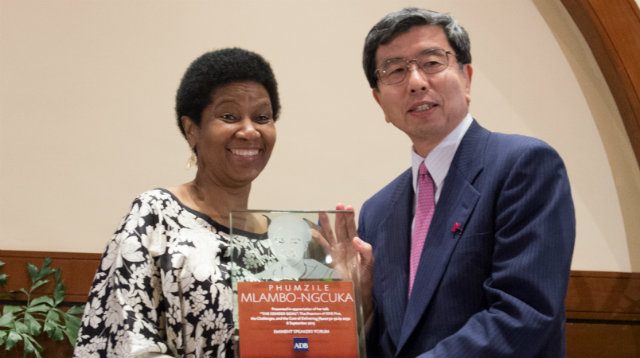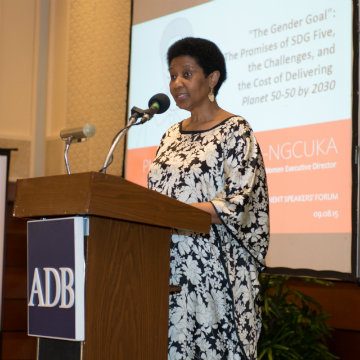SUMMARY
This is AI generated summarization, which may have errors. For context, always refer to the full article.

MANILA, Philippines – President Benigno Aquino III has a special place ready for him on September 27 in New York City, according to Phumzile Mlambo-Ngcuka, executive director of the United Nations Entity for Gender Equality and the Empowerment of Women (UN Women).
Aquino has been invited to a high-level global leaders’ meeting in New York that will launch Sustainable Development Goals (SDGs) and the UN vision of Planet 50-50 by 2030, the “most ambitious global effort since the UN Declaration of Human Rights in 1948,” Mlambo-Ngcuka said in a recent forum at the Asian Development Bank (ADB).
Part of the UN Women leader’s travel mission to the Philippines was meeting Aquino and delegations from the Department of Foreign Affairs (DFA), the Philippine Commission on Women (PCW) and other groups.
Mlambo-Ngcuka said the Philippines is being considered as one of 10 countries in the UN Women’s “HeforShe” campaign that promotes partnership with men and boys in gender quality. It will count in 10 heads of state, 10 CEOs, 10 university principals to lead the change.
Planet 50-50
While in the Philippines, Mlambo-Ngcuk noted that the SDGs were a result of a review of the progress of the Millennium Development Goals (MDGs) and the Beijing+20 in 168 countries. The MDGs were signed by 189 countries including the Philippines at the start of the millennium and the Beijing Platform for Action was adopted in the international conference on women in Beijing, China 20 years ago. Both drew blueprints for gender equality efforts throughout the world.
Meanwhile, the UN’s vision of a Planet 50-50 by 2030 is a world where women and men, girls and boys have substantive equality, Mlambo-Ngcuka said.
“Never has there been a moment like this where there is a real possibility to substantially change power relations between men and women; a time for a bold move,” the UN Women leader stressed.
She said the 17 SDGs include a stand-alone goal – goal 5 – on gender quality and women’s empowerment that cuts across all other goals. It has the following provisions:
- End all forms of discrimination and violence against all women and girls in the public and private spheres
- Eliminate all forms of harmful practices such as child, early and forced marriage, and female genital mutilation
- Recognize and value unpaid care and domestic work and promote shared responsibility within the household
- Ensure women’s full participation and equal opportunities for leadership at all levels of decision-making
- Ensure universal access to sexual and reproductive health and rights. (READ: Emma Watson to men: Gender equality is your issue, too)
“If goal 5 is implemented with the gender equality targets across all other goals, 2030 will be a high point for gender relations and promises to usher a better world for generations to come,” she said.
“We are calling on the global community – not only on governments to make tangible and strategic commitments to bring goal 5 to life, together with its related gender equality and women’s empowerment targets. We are asking all major institutions to understand, to commit and act,” she added.

Equal pay for equal work
During her talk in the ADB, Mlambo-Ngcuk sounded off the most attention to the campaign on “equal pay for equal work,” which she said is “the key to ending economic discrimination against women in the private and public sector.
Mlambo-Ngcuka said women in Asia receive 30% less than men; globally, it’s 24%, citing International Labor Organization (ILO) data that also indicates the total cost of gender inequality in employment across Asia alone at US$45 billion a year.
“This is based on the fact that 45% of working-age women in Asia are outside the labor force, compared to just 19% of men,” she noted.
If female employment were to match male employment, she said the gross domestic product (GDP) will increase everywhere, such as 19% in South and Southeast Asia and 27% in the Middle East and North Africa.
She said societies that have allowed women to be paid less than their male peers for equal work have violated their basic rights, and these are occurring everywhere among the women of Wall Street in the US to women farmers in Brazil and factory workers in South Africa.
Worldwide, she said there are 75% of women who work outside their homes in the informal sector who receive minimum wage and do not have protected work that will make them unqualified for pensions. She also cited unpaid care and domestic work as a structural cause of gender inequality with impact of a lifetime.
Mlambo-Ngcuka also called attention to infrastructure for child care, which she said are important as roads and clinics, water, and sanitation infrastructure, and more support and promotion for family planning that will also redound to better educated girls who stay in school and finish their education.
She noted the persistent issue of violence against women, which, even if countries have not put costs on it, is similarly costly as gender gaps in work and employment.
“Violence against women and girls continues to affect one in 3 women around the world. The cost in pain, degree of violation or rights, and trauma paralyze women and destroy families,” she said.
She said that by 2020, the UN will take stock at an international forum to see if countries are going in the right direction and whether or not they are getting closer to achieving substantive gender equality.
The UN Development Programme (UNDP) indicates the Philippine report’s performance in the MDGs that has 8 goals, which, by its final year 2015, is still wanting in improvements on poverty reduction, maternal health, and HIV and AIDS.
The Philippines appears to be on track in providing universal access to primary education; providing educational opportunities for girls; reducing infant and under-five mortality; reversing the incidence of malaria; increasing tuberculosis detection and cure rates, and increasing the proportion of households with access to safe water supply. – Rappler.com
Add a comment
How does this make you feel?
There are no comments yet. Add your comment to start the conversation.